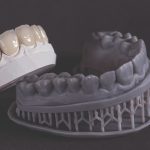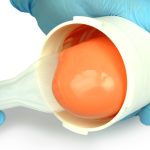There are a many different impression materials on the market. Some of these, like hydrocolloids, are intended only for preliminary impressions while others, like elastomers, offer better performance and can therefore be used for final, precision impressions. Elastomers are also used to make other materials in addition to impression silicones.
Impression silicones come in two types: addition and condensation.
Condensation silicones
Condensation silicones (polydimethylsiloxanes or first generation silicones) were first introduced for dental applications in the 1950s (2). They consist of a base molecule, dimethylsiloxane (a silicone polymer) with metal oxides and silica powders added to increase density. These substances react when a liquid or paste activator is added. Tin(ii) octoate is the most common activator. Volatile substances (alcohols) are released during the condensation reaction. All the reactions involved occur at ambient temperature and for this reason condensation silicones are often referred to as RTV (room temperature vulcanisation) silicones.
They have to be mixed manually using a metallic spatula in the case of the more fluid types. Mixing and working times are generally short, so a certain amount of experience is needed to work the material properly within the given time frames. Reaction time is also directly proportional to ambient temperature: reaction is faster in warm rooms and slower in cold rooms.
Mechanical characteristics of condensation silicones
Condensation silicones have excellent mechanical characteristicsincluding very high elasticity, which allows them to overcome undercuts without suffering any significant or permanent deformation. They are also cheap to buy, especially compared to addition silicones and other elastomers, and are extremely versatile: they can be used for fixed and removable prostheses, are compatible with standard and individual impression trays, and can be used in single and double step techniques. (3)
Another important benefit of these materials is that they are hydrophobic. They are therefore not liable to problems of syneresis or imbibition, meaning that their dimensional stability is not affected by ambient humidity.
They do, however, have their disadvantages too. Dimensional stability is poorer than with addition silicones. Contraction is caused by the release of alcohol molecules as a by-product of the condensation reaction. (4) Condensation silicones are not adhesive, so suitable adhesives must be used when working with non-retentive impression trays.
Hydrophobia can also be a disadvantage if the field is not perfectly clean and traces of saliva or blood are present. Use of a highly hydrophobic material under such conditions can produce an impression with microscopic defects (bubbles and holes) especially in areas near the gingival margin. As confirmed by literature, provided the field is kept perfectly clean and no more than 15/20 minutes are allowed to pass before the stone model is made, impressions with condensation silicones can give extremely accurate results. (5)
Addition silicones
Addition silicones (polyvinylsiloxanes or second generation silicones) were developed in the early 1980s (2). Addition silicones differ from condensation variants in that the vulcanisation process that forms the polymer is triggered by the addition of a catalyst. The process is the result of cross-linking between the vinyl groups of the polymer and the silane groups activated by a platinum salt catalyst (chloroplatinic acid).
Unlike the condensation reaction, that of addition silicones does not generate by-products. Dimensional stability is therefore far greater than in the case of condensation polysulphides and silicones, which are liable to the syneresis of reaction by-products. Impression taking techniques are identical to those adopted with condensation silicones. (6)
Mixing and working polyvinylsiloxanes
The mixing and working of polyvinylsiloxanes is an extremely simple process, unlike that of preparing condensation silicones. Recent years have seen growing demand for ergonomic solutions (7) like automatic mixing cartridges (manually operated by a dispenser) and automatic mixing systems (electrically operated) to which produce a homogeneous, bubble-free and perfectly proportioned mix, giving a better quality impression and requiring less effort from the dentist.
Polyvinylsiloxanes boast excellent mechanical properties. Elastic recovery is the best of all elastomers and dimensional stability is so good that the impression can be used to duplicate models. Another advantage of addition silicones is their thixotropic behaviour, or their tendency to become more fluid when pressure is applied. Thanks to this property, less dense materials are able to flow easily into the gingival sulcus and record details with greater precision.
The hydrophobia of addition silicones
As with condensation silicones, addition silicones are naturally hydrophobic. It is therefore important to maintain a clean field, as traces of blood or saliva can provoke defects. In recent years, researchers have tried to develop more hydro-compatible addition silicones for use in wet areas such as the gingival sulcus. Thanks to the addition of surfactants, formulae have become more wettable and hydrocompatible without becoming hydrophilic and risking phenomena of syneresis or imbibition. (8)
One disadvantage of addition silicones is the sensitivity of the platinum catalyst to compounds containing sulphur, which can even completely inhibit the reaction. (9) Unlike condensation silicones, latex gloves cannot be worn when handling addition silicones since sulphur compounds like diethyldithiocarbamates are added to the latex during the vulcanisation process. (10) Care must also be taken to avoid interaction with other product types, including certain liquid astringents, especially those containing aluminium sulphate. (11.12)
Professional clinical silicones
Silicones are elastomers with properties that are clinically essential to the production of accurate impressions. Addition silicones are a more recent development than condensation silicones and offer generally improved characteristics. While they are able to produce better results, however, greater care must be taken to avoid interactions that might inhibit polymerisation.
Zhermack supplies a wide range of condensation and addition silicones to satisfy all clinical needs.
Bibliography
- Baldissera, P et al (2019). Materiali e tecnologie odontostomatologiche – terza edizione.
- Prophet, A. S. (1982). Walter Hoffmann-Axthelm, History of dentistry, Berlin and Chicago, Quintessence Publishing Co., 1981, 8vo, pp. 435, illus., $100.00. Medical History, 26(2), 217-217.
- Naumovski, B., Bundevska, J., & Kapusevska, B. Comparison of double-phase impression technique in 1 step and 2 steps by evaluating dimensional stability and accuracy of condensation silicones.
- Donovan, T.E. and Chee, W.W. A review of contemporary impression materials and techniques. Dent. Clin. N. Am., 2004; 48:445.470
- Gonçalves, F. S., Popoff, D. A. V., Castro, C. D. L., Silva, G. C., Magalhães, C. S., & Moreira, A. N. (2011). Dimensional stability of elastomeric impression materials: a critical review of the literature. European Journal of Prosthodontics and Restorative Dentistry, 19(4), 163.
- Hung, S. H., Purk, J. H., Tira, D. E., & Eick, J. D. (1992). Accuracy of one-step versus two-step putty wash addition silicone impression technique. The Journal of prosthetic dentistry, 67(5), 583-589.
- Craig, R. G. (1985). Evaluation of an automatic mixing system for an addition silicone impression material. Journal of the American Dental Association (1939), 110(2), 213-215.
- Cullen, D. R., Mikesell, J. W., & Sandrik, J. L. (1991). Wettability of elastomeric impression materials and voids in gypsum casts. The Journal of Prosthetic Dentistry, 66(2), 261-265.
- Reitz, C. D., & Clark, N. P. (1988). The setting of vinyl polysiloxane and condensation silicone putties when mixed with gloved hands. The Journal of the American Dental Association, 116(3), 371-375.
- Causton BE, Burke FJ, Wilson NH. Implications of the presence of dithiocarbamate in latex gloves. Dent Mater. 1993;9:209-13.
- Machado, C. E. P., & Guedes, C. G. (2011). Effects of sulfur-based hemostatic agents and gingival retraction cords handled with latex gloves on the polymerization of polyvinyl siloxane impression materials. Journal of Applied Oral Science, 19(6), 628-633.
- Tarighi, P., & Khoroushi, M. (2014). A review on common chemical hemostatic agents in restorative dentistry. Dental research journal, 11(4), 423.
Do you want more information on Zhermack Dental products and solutions?
Contact us




 Zhermack SpA has been one of the most important producers and international distributors of alginates, gypsums and silicone compounds for the dental sector for over 40 years. It has also developed solutions for the industrial and wellbeing sectors.
Zhermack SpA - Via Bovazecchino, 100 - 45021 Badia Polesine (RO), Italy.
Zhermack SpA has been one of the most important producers and international distributors of alginates, gypsums and silicone compounds for the dental sector for over 40 years. It has also developed solutions for the industrial and wellbeing sectors.
Zhermack SpA - Via Bovazecchino, 100 - 45021 Badia Polesine (RO), Italy.


